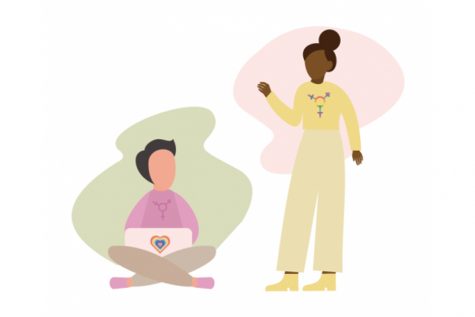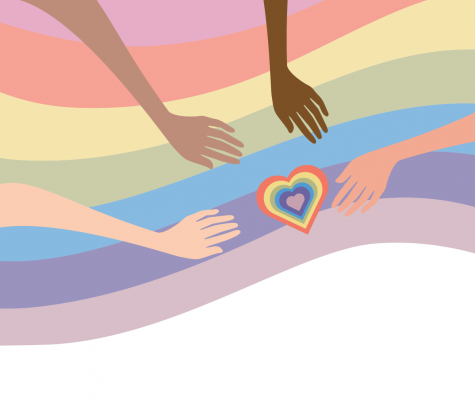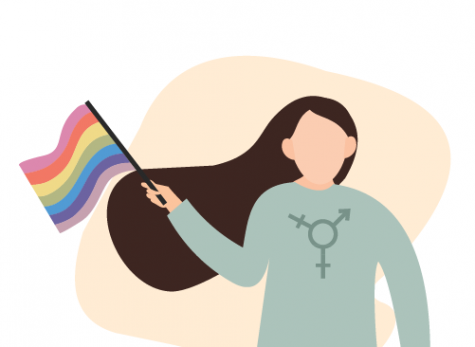From the new normal to new pronouns: The pandemic provides space for gender reflection

Editor’s note: This article is one in a series of stories from the Communication Department’s award-winning Echo magazine, featured this summer on the Chronicle site.
_____________________________________
Sitting outside in their hammock, in the aftermath of a “wicked bad breakup” with a self-re-examination crisis looming, Becks Michael came to a realization: They weren’t cisgender.
Michael, a junior at the University of Wisconsin-Madison, has been using both she/her and they/them pronouns and identifying as a nonbinary, genderqueer individual since the summer months of the pandemic.
As a self-described “rough and tough” tomboy whose afternoons growing up were spent climbing trees and getting in trouble, Michael says they have never felt super-feminine.
While Michael has been contemplating their gender identity for years, it wasn’t until quarantine that they took one step closer to “transcend[ing] gender” and becoming a “genderf*ck icon” like singer-songwriter Janelle Monáe.
“I was spending just a lot of time outside of thinking about who I am, what I’m here to do and how I’m going to go about life,” Michael says. “Because of the pandemic, I had a lot more opportunity to play around with the clothes that I wear, and that was really thrilling.”
Since the start of the pandemic, conversations burgeoned across glowing screens — through TikTok comments, Twitter threads, Instagram posts and even theatrical productions — about their relationship to their gender and pronouns. Cisgender, nonbinary and transgender people alike have updated their Zoom names to include they/them, she/they and he/they in parentheses.
Experts on LGBTQ+ and gender studies say the ongoing social isolation and opportunity to connect with a like-minded community online have in many instances provided safe spaces for people to explore how they see themselves and others.
“Understanding who you are, understanding identity, understanding what’s important to you — the pandemic has put that in focus for a lot of people,” says Monica Gupta Mehta, CEO and founder of the nonprofit Normalizers. “It has removed a lot of the societal pressures that are part of our gender expression.”
Mehta, an educator who runs the TikTok account @monicatheteacher, says she has noticed an increased interest on the app surrounding the topic of gender, adding that her videos on gender identity and pronouns typically get hundreds of thousands of views.
Originally started in November 2020 as a way to teach people about social and emotional learning, health and sex education, Mehta says the account now has more than 60,000 followers and provides a safe space for those in the LGBTQ+ community to receive education, advice, support and ask questions.
“I might not have the answer, but I will research it, I will talk to doctors, I’ll talk to therapists, I’ll talk to other people and get answers,” Mehta says.
She runs the TikTok account and makes videos on various subjects with the help of her 14-year-old, Ash, who uses she, he and they pronouns.
Ash Mehta says it has felt good to help create a community where people can come together and find themselves. They say realizing they were nonbinary relieved the “terrible pressure” of their dysphoria and allowed them to be their authentic self.
“Before I was quarantined, I was stuck in what people expected me to be,” Ash Mehta says. “It’s harder to change who you are when you’re constantly interacting with people. Quarantine took all of that expectation away and allowed me more space to question who I was.”
According to the Trevor Project’s 2020 National Survey on LGBTQ Youth Mental Health, 75% of LGBTQ youth use he/him or she/her exclusively and 25% use either use they/them exclusively, neopronouns such as ze/zir or fae/faer or a combination of he/him, she/her and they/them.
A 2015 U.S. Transgender Survey states that more than one-third of respondents identified as nonbinary or genderqueer, and according to a 2018 Pew Research Center survey, around 20% of U.S. adults know someone who uses gender-neutral pronouns. Around half of adults say they are comfortable using pronouns outside the gender binary.

Terrain Walker, a 19-year-old freelance photographer in the South Loop who uses he/they pronouns, says if it wasn’t for the pandemic and all the time it gave them to think about themself, it likely would have taken them longer to figure out their gender identity.
Walker says summer 2020 was the first time they thought about how they don’t want to have a relationship with gender in general.
“I don’t really agree with male and female gender roles,” Walker says. “I feel like it’s a lot more nuanced than that [and with] the way that the world has been for so long, it’s made people forget that.”
Kayla Wruk, 22, says it just so happened to be during the pandemic that they decided to stick with they/them pronouns rather than she/they pronouns, which they had used throughout college.
“Gender just isn’t a very important thing to me,” says Wruk, who works at a steel mill in Wisconsin. “I always went by queer for a long time in terms of gender and sexuality, because I really don’t feel the need to be any more specific than that.”
Stephanie Skora, associate executive director at Brave Space Alliance, says being away from a cis-supremacist society during the pandemic has allowed people to explore whether or not they’re truly comfortable in the gender that they thought they were, or whether they were just conforming to a set of expectations.
She says now is one of the easiest times for a person to transition physically or socially and become comfortable existing in their new self away from the public eye.
“It’s incredibly normal to question your gender, or your sexuality,” Skora says. “Don’t be afraid to try something new, even if it doesn’t work.”
Meggy Roth, a 31-year-old Waterloo, Iowa resident says working from home as a debt collector has given her the chance to figure out her identity while transitioning, from honing her voice to experimenting with her style to understanding the type of person she is.
Also, Roth says when going outside, she feels emotionally safer with a mask, because she can cover up the bottom half of her face and “pass.”
“I think COVID-19 not happening would have made my transition so much harder,” she says. “I can’t really say enough how great it is to be isolated while I pump my body as full of estrogen and progesterone as I can.”
She says the pandemic has also allowed her to shrink her social circles and avoid those in public that would question her gender identity.
“It’s so great that I can condense my world into only the most supportive and kind people,” Roth says.
However, Roth says she is still excited to eventually “rejoin society” and perform comedy sets at open mics again now that she has had time to learn more about herself and become happy with the way that she looks.

Senior staff therapist and group coordinator Deb Zutty, who hosts gender experience groups at IntraSpectrum Counseling, says there are pros and cons to coming out and changing one’s name or pronouns during the pandemic.
She says on the one hand, the ability to come out to family and friends without having to see them in person gives people a lot more freedom and autonomy in terms of when and how they present themselves.
Zutty added that people have more permission to be playful or explorative and change their display name on Zoom.
Despite this, there can also be more anxiety surrounding one’s name, she says, as it is constantly attached to them on screen. Zutty says there can be issues with cyberbullying as well as transphobic families at home.
Zutty recommends those looking for a way to process their gender and feelings of anxiety and dysphoria try out one-on-one therapy sessions.
Max Deckers, a 20-year-old from Oviedo, Florida, says they had to figure out the pronouns they wanted to use all on their own and it was difficult without significant help from friends or family.
“It’s a little discouraging in the pandemic, because all we have is work, school, YouTube [and] online people,” Deckers says. “So we have no guidance.”
They say before the pandemic, it was also hard to be themself and their identity has always been something they have kept in their home. Moving forward, they say it will be interesting to see what re-entering society looks like with their new identity.

Erica Chu, an instructor of English at Harry S. Truman College, says you should always check with somebody who has recently come out to see if they are ok with having their new name or pronouns used in other groups or settings before accidentally outing them.
Chu says the most important thing you can do as someone who knows a person in the process of changing their identity and gender expression is educating yourself through videos, internet resources and following people who are talking about similar topics.
“Don’t let the fear of messing up keep you from trying,” they say. “You’re going to mess up somebody’s pronouns. When you do, just apologize and move on—don’t make a big deal out of it. If the person seems hurt afterwards, you can check in with them about it.”
For those questioning their identity, Chu says they should seek out a wellness center or a therapy group in addition to talking to their friends, family and even social media groups for support.
“Community is extremely important,” Chu says. “If you try to do everything by yourself, it’s going to feel very, very difficult.”

